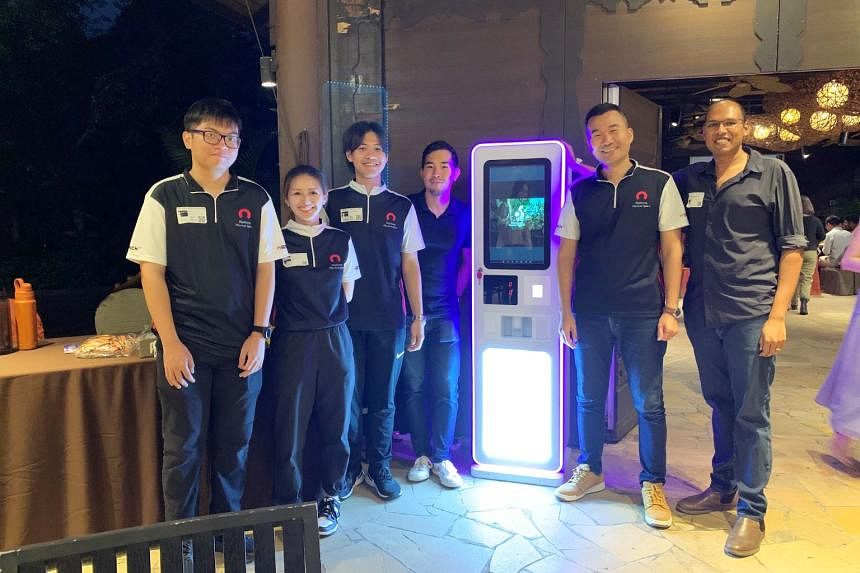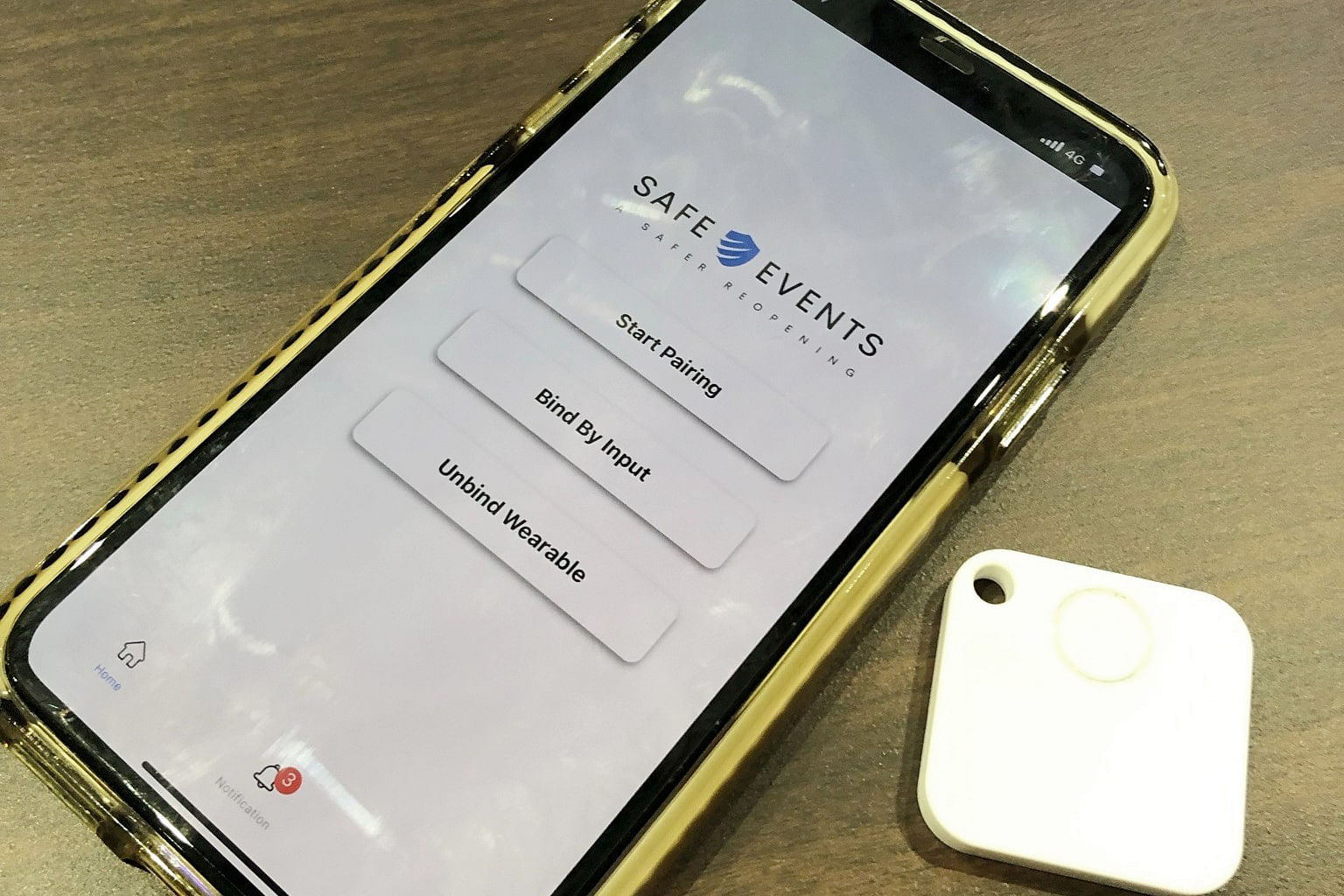Personalised museum experiences and smart wristbands
Personalised museum experiences and smart wristbands: S’pore start-up develops customer-centric technologies through crowd-sourcing programme
With successful collaborations inked through the IMDA’s Open Innovation Platform, Trakomatic now has more doors open, including in other sectors

Trakomatic and Viatick members with the wristband dispensing machine at Mandai Wildlife Reserve. The smart wristband, which will be worn by visitors, makes ticketing at the parks hassle-free and also reduces the number of physical touchpoints. PHOTO: TRAKOMATIC
When you visit museums managed by the National Heritage Board (NHB) in
the future, you may be able to get personalised recommendations on which
exhibitions and programmes to check out.
NHB and local tech firm Trakomatic conducted a trial employing artificial intelligence (AI) and facial recognition technologies to better understand visitor preferences and behaviours within the museum. This could allow the museums to personalise experiences and information served based on individual preferences and interests.
It all started in 2020, when NHB was looking for ways to boost museum visitors’ experience through the use of tech. It asked for proposals via the Infocomm Media Development Authority’s (IMDA) Open Innovation Platform (OIP), a virtual crowd-sourcing platform that connects businesses facing challenges with relevant technology providers.
Trakomatic’s submission demonstrated how NHB could leverage smart technologies to enhance the visitor journey at museums before, during and after their visits. This involves studying crowd sizes at exhibitions while providing personalised recommendations, as well as gathering post-visit feedback from visitors.
Enthused by Trakomatic’s ideas, the two organisations began working on the system in 2022, following a delay caused by the Covid-19 pandemic. After five months of development, a promising prototype was created and underwent successful initial testing. The prototype delivered valuable insights into visitors’ preferences, and demonstrated its potential in recommending engaging content for visitors. The partners completed the first pilot in December last year, and are currently evaluating the results.
Opening more doors
Since Trakomatic earned the chance to work with NHB, it has won three other OIP challenges, put up by the Sentosa Development Corporation (SDC), Singapore Association of Convention and Exhibition Organisers and Suppliers (SACEOS) and Mandai Wildlife Group (MWG).
With SDC, Trakomatic designed a sophisticated ecosystem that provides a near real-time pulse of Sentosa, pinpointing where crowds are and their journeys around the island. The solution, which comprises a networked system of new and existing sensors, beacons and a cloud-based platform enriched with AI and data analytics, is a leap forward for SDC in efficiently managing traffic flow around the island.
For example, with the solution integrated into its operations, SDC can anticipate how crowds will build up during peak periods and proactively deploy manpower to manage and divert visitors more effectively. Since November last year, Trakomatic has been deploying the solution at the upcoming attraction precinct, Sentosa Sensoryscape.
For SACEOS, Trakomatic collaborated with Singapore software company Viatick to produce tools to help event organisers run conferences and other meetings safely during the pandemic. These included facial recognition systems for contactless registration, and Bluetooth dongles carried by attendees to flag unauthorised interactions between those assigned to different zones.

Trakomatic and Viatick have also come up with this bluetooth-enabled dongle that attendees can carry to help event organisers detect unauthorised interactions between people assigned to different zones at an event. PHOTO: TRAKOMATIC
After working together successfully for the SACEOS project, Trakomatic and Viatick joined forces again for a winning proposal for MWG. This time, it was a hands-free digital pass that visitors can use to check into and explore its parks, reducing the number of physical touchpoints and hassle of ticketing. The final product is a smart wristband solution that recently completed a proof-of-concept phase, giving MWG insight into the technology’s feasibility for future stage planning.
Trakomatic co-founder and chief executive officer Allen Lin shares that working with Viatick enabled the two businesses to mount stronger bids for the OIP challenges. “We have unique strengths in the tracking space. Trakomatic focuses on developing video analytics technology to track human behaviour in physical spaces, and Viatick uses Internet-of-Things sensors that employ radio frequency for tracking.
“By combining our various technologies, we can offer much more value to our clients, better address OIP problem statements which are not easily solvable with off-the-shelf systems, and customise solutions that the market demands.”
An innovative platform that lifts all boats
The OIP has advantages for both companies seeking and supplying solutions.
“Companies confronting issues can get access to a network of solvers who are not only knowledgeable but also ready and willing to share the risks of co-developing solutions,” says Mr Edmas Neo, vice president of MWG’s transformation office. This motivates organisations to tap external expertise and embrace advanced ways of solving problems.
Unlike tenders with rigid specifications, the OIP has more flexibility for innovation, expanding the range of possible solutions and fostering the development of technologies that both meet businesses’ needs and push boundaries, Mr Lin adds.
Furthermore, with many completed challenges, the OIP process is mature and well-tested. Companies seeking solutions under the OIP programme also get to benefit from extensive support, such as complimentary consultations with industry experts, in addition to access to a global pool of tech solvers at their fingertips, Mr Neo highlights.
With the collaborative relationships built through the OIP, companies are more likely to keep working together after the OIP challenges. For example, NHB, SDC and MWG have committed to larger roll-out plans for the technologies that they co-developed with Trakomatic.
Mr Lin notes that the OIP is especially beneficial for smaller firms, and has opened up new opportunities and business segments for Trakomatic. “Smaller companies like ours often face challenges in presenting our offerings to larger organisations. The OIP makes it easier for us to get their attention.”
With the OIP being a platform open to all, it levels the playing field for tech solvers. They can get access to diverse challenges, opportunities for collaboration – as Trakomatic found with its partnership with Viatick – higher exposure and visibility through their proposal submissions, and even monetary reward by winning the prize money put up by corporates for solutions. All these can help tech solvers to supercharge their business.
Before taking part in OIP challenges, Trakomatic’s customers were mostly in the retail industry. Through the OIP, it expanded into the tourism sector and made a splash with influential clients such as NHB, SDC and MWG. It has also gained insights into such organisations’ day-to-day operations, allowing it to refine future pitches within the sector.
Trakomatic continues to keep an eye out for new OIP challenges, and will participate in suitable ones. MWG’s Mr Neo adds: “We encourage organisations embarking on innovation journeys to use the OIP. We hope that the number and frequency of OIP challenge calls can increase, thereby providing more opportunities to support a myriad of projects.”
Learn more about how you can be connected with a tech solution provider and scale your business.
Source: The Straits Times

